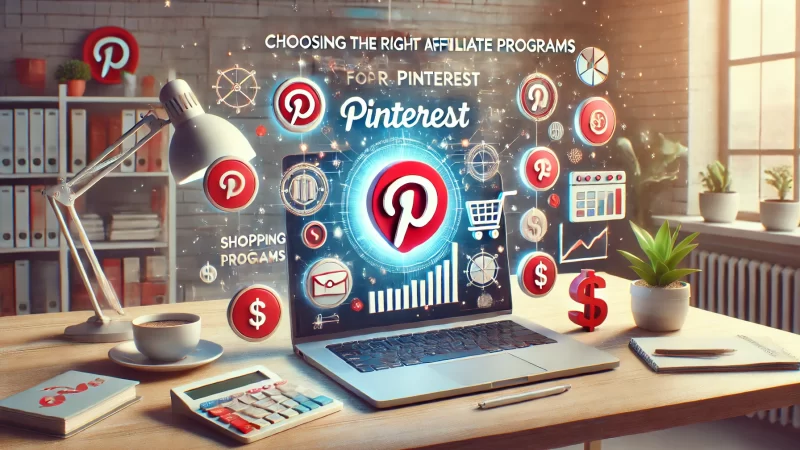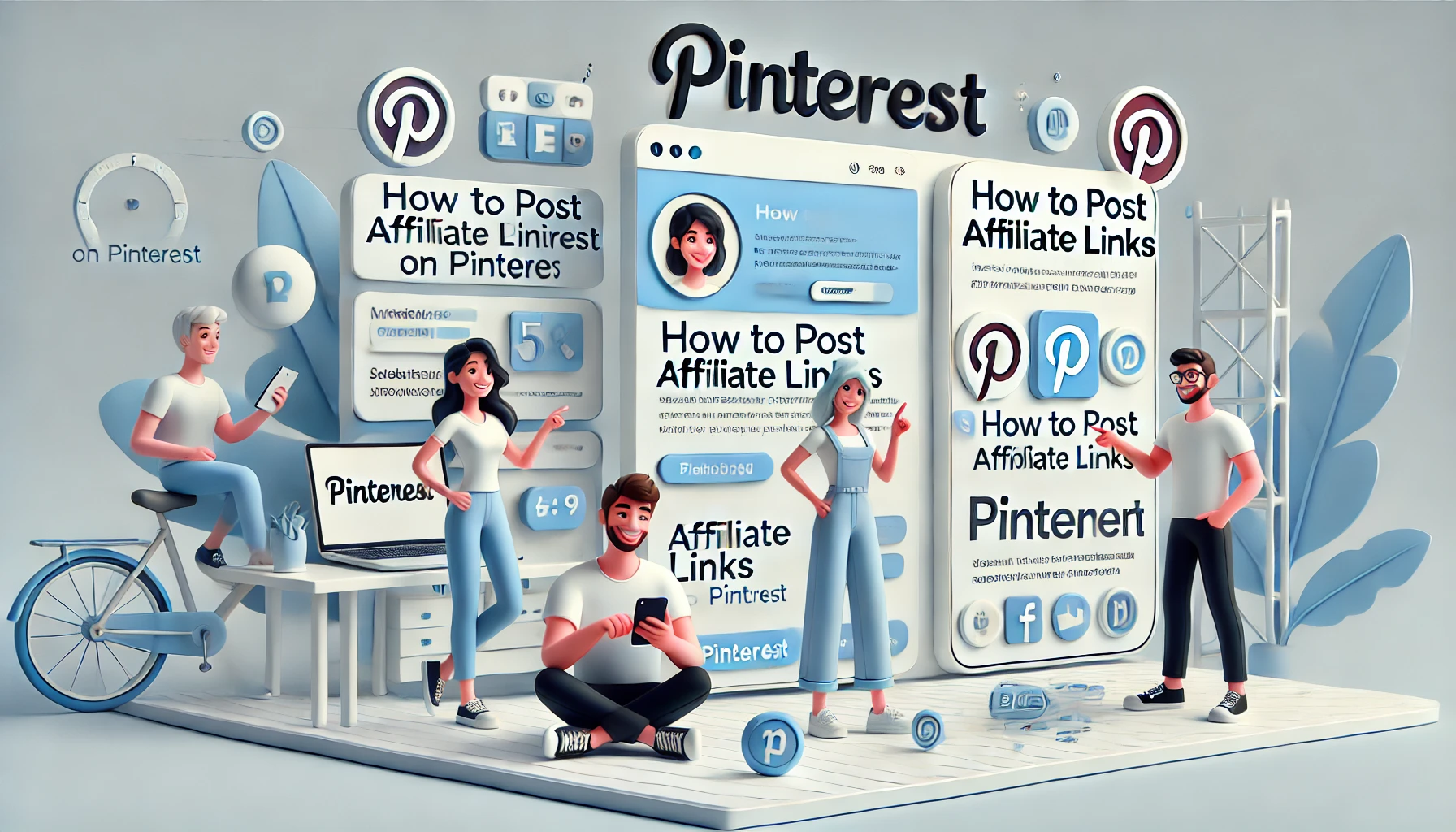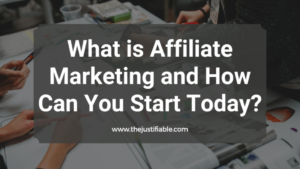Are you wondering how to post affiliate links on Pinterest without violating policies? Want to know the best practices for adding affiliate links that maximize clicks and conversions?
This guide will explore all aspects of using affiliate links on Pinterest, helping you increase earnings while following Pinterest’s guidelines.
Understanding Affiliate Links And Pinterest Policies
Affiliate links on Pinterest can be a powerful income stream if you understand the platform’s rules and how affiliate links work. By grasping the essentials of Pinterest policies, you’ll ensure a smooth, successful affiliate marketing experience.
What Are Affiliate Links And How Do They Work?
Affiliate links are unique URLs that help track referrals from one site to a merchant’s page. When someone clicks your link and makes a purchase, you earn a commission. It’s simple: you recommend, they buy, and you get rewarded.
I believe affiliate links are an ideal choice for Pinterest since the platform thrives on visual discovery and inspiration, which naturally leads to buying decisions. Each affiliate link embeds your unique ID, ensuring you get credit for every qualifying purchase, making this a win-win for creators and marketers alike.
Pinterest users are often in discovery mode, meaning they’re ready to click and explore new ideas, products, and brands. When you embed affiliate links thoughtfully within appealing pins, you tap into this audience’s curiosity. I recommend creating eye-catching, informative pins that seamlessly guide users toward exploring the products you promote, setting the stage for natural conversions.
Affiliate marketing’s simplicity is part of its appeal. Once you grasp how these links work, it’s just a matter of sharing your authentic product recommendations, leading followers to items that can genuinely benefit them while earning you commissions.
Pinterest’s Guidelines For Affiliate Links
Pinterest allows affiliate links, but specific rules govern their usage. Following Pinterest’s affiliate guidelines keeps your account safe and builds user trust. Pinterest advises transparency, meaning you must disclose affiliate links to viewers so they’re aware of potential sponsored content. I suggest using straightforward language to convey this in descriptions, keeping it friendly yet clear.
Using too many affiliate links on Pinterest could lead to flagged content, so balancing valuable content and monetized pins is essential. I recommend pacing your affiliate posts and incorporating regular, non-promotional pins. This not only aligns with Pinterest’s policies but also enhances your profile’s overall appeal.
Lastly, avoid promoting prohibited items or services in affiliate links. Pinterest has specific categories it restricts, so choosing products wisely ensures compliance. Following these guidelines doesn’t just protect your account—it also makes your pins a trusted source for followers.
Avoiding Common Mistakes With Affiliate Links On Pinterest
One common mistake with Pinterest affiliate links is failing to disclose their nature, which can lead to penalties or account suspensions. Always be transparent, as it fosters trust with your audience and complies with Pinterest guidelines. This clarity makes users more likely to click your links, knowing exactly what to expect.
Overloading Pinterest boards with affiliate links can also make your profile seem overly promotional, which might turn followers away. I advise mixing in valuable, non-affiliate content to keep your profile well-rounded and genuinely helpful. By focusing on a blend of promotional and informational pins, you can build a well-rounded and engaging Pinterest presence.
A third mistake is overlooking quality visuals, which is crucial for engagement. Since Pinterest is a visual platform, I suggest investing time in creating high-quality pins that resonate with your audience. This combination of transparency, balance, and quality visuals will set you up for long-term success on Pinterest.
Best Practices For Safe Affiliate Link Posting
Safe affiliate link posting on Pinterest starts with transparency and ends with regular pin updates. Disclosures are essential, and I recommend keeping them simple yet visible. Something as straightforward as “affiliate link” in the pin description ensures clarity without cluttering your message.
Organize your affiliate content on themed boards, such as “My Favorite Home Products,” where users know what to expect. Boards dedicated to a specific theme make it easier for followers to find products they’re interested in, leading to higher engagement and conversions.
Another tip is to track the performance of your pins. Pinterest offers insights, and by monitoring which affiliate pins perform best, you can refine your content strategy. Adjusting based on results keeps your strategy aligned with what your audience loves. Safe and effective affiliate marketing hinges on this proactive, informed approach.
Choosing The Right Affiliate Programs For Pinterest

Finding the right affiliate programs for Pinterest enhances earnings and engagement. Focus on programs offering high-converting products that resonate with Pinterest’s visually inclined audience, allowing for easy, seamless sharing.
Selecting High-Converting Affiliate Programs
High-converting affiliate programs offer products that align with Pinterest’s image-centric approach, allowing you to showcase items that visually engage users. I suggest looking for programs that match your niche and interests, as authenticity boosts conversions.
Select programs with products that have a strong appeal, and make sure they’re items your audience will naturally be drawn to. This strategy not only increases clicks but also builds your authority as a genuine recommender. With Pinterest users eager for inspiration, relevant, attractive products work wonders in grabbing attention.
Consider how product images fit within Pinterest’s vertical pin layout. High-quality images that fit this format are more likely to get pinned, repinned, and clicked. By choosing visually appealing products, you’re setting yourself up for higher conversion rates on Pinterest.
Popular Affiliate Networks Compatible With Pinterest
Popular networks like Amazon Associates, ShareASale, and RewardStyle are widely used on Pinterest due to their broad product selection and ease of integration. These networks allow flexibility in choosing items across various categories, from home decor to fashion, fitting seamlessly into Pinterest’s diverse interests.
I recommend Amazon Associates for beginners because it offers nearly limitless product choices, and users are familiar with the platform. For those in specific niches, RewardStyle is effective, especially in fashion, as it provides access to exclusive brands.
ShareASale is another versatile network, offering an array of merchants across many niches, which is perfect for those with varied boards on Pinterest. These popular networks streamline the affiliate linking process and make compliance with Pinterest’s rules straightforward.
Tips For Choosing Affiliate Programs In Your Niche
Choosing affiliate programs tailored to your niche is critical for effective Pinterest marketing. I suggest looking into programs offering products you’d genuinely recommend—authenticity is powerful, and Pinterest followers appreciate sincere endorsements.
Focus on programs that complement your existing boards. If your content is about travel, select programs offering travel gear, guides, or gadgets that resonate with this theme. This strategic approach improves engagement since the products naturally match the interests of your followers.
Check for affiliate programs that offer competitive commissions. While you want products that engage your audience, it’s equally important that your efforts are financially rewarding. Balancing relevance and profitability is the key to long-term success with Pinterest affiliate marketing.
Evaluating Commission Rates And Product Demand
High commission rates mean greater earnings per sale, but product demand is just as essential. Evaluate both to ensure you’re choosing items that not only pay well but also attract high user interest. Pinterest is excellent for trending items, so look for products in demand within your niche.
I recommend focusing on products with consistent demand, which helps maintain steady income and engagement. Tools like Buzzsumo or Pinterest’s own insights can show whether a product category is gaining popularity, allowing you to align your pins with what’s currently hot.
Balancing commission rate with demand also requires checking the payout structure. Some programs offer recurring commissions, while others pay only once. By choosing a mix of both, you can diversify your earnings and build a more sustainable affiliate income. This balance of demand and profitability leads to a more reliable Pinterest affiliate strategy.
How To Create Pins With Affiliate Links
Creating pins with affiliate links can be highly effective if done right. Focusing on design, description, and proper disclosures will make your affiliate pins more engaging and trustworthy, increasing your chances of clicks and conversions.
Designing Click-Worthy Pins For Affiliate Products
Designing pins that capture attention is key to successful affiliate marketing on Pinterest. I suggest focusing on clear, bold visuals that highlight the product’s appeal. Think about what will stand out in the feed—contrasting colors, readable fonts, and high-quality images help your pin look professional and enticing.
Consider using vertical images for maximum screen real estate since they perform best on Pinterest. This layout ensures your pins are more visible as users scroll through their feeds. I recommend using simple yet powerful design tools like Canva, which has templates that make creating Pinterest-specific graphics easier and faster.
Including a text overlay can also help communicate the product’s main benefits at a glance. Text overlays act like mini-headlines, letting users quickly understand the value of the product you’re sharing. For example, a phrase like “Must-Have Kitchen Gadget” can grab attention instantly, increasing clicks and engagement.
Writing Engaging Pin Descriptions With Keywords
An engaging description plays a big role in boosting your pin’s visibility on Pinterest. Start by naturally incorporating keywords like “how to post affiliate links on Pinterest,” as well as relevant product keywords, to increase searchability. This simple step can help your pins reach more interested viewers.
I suggest keeping descriptions clear, honest, and informative to give viewers an accurate sense of what they’ll find when they click. Highlight the product’s unique benefits or uses, explaining why it’s a great choice. By focusing on user benefits, you make the pin not just a promotion but a helpful suggestion.
Consider adding personal insights or experiences with the product, which can make descriptions more relatable. Statements like, “I love using this for quick meal prep,” create a connection with readers and enhance credibility. This mix of keywords and personal touch makes the description both search-friendly and engaging.
Including Affiliate Disclosures On Pins
Including an affiliate disclosure is essential for transparency and aligns with Pinterest’s guidelines. I suggest keeping it short and simple, like “Affiliate Link” or “Affiliate,” added right in the pin description. This clarity builds trust with your audience while meeting platform requirements.
You don’t need to make the disclosure the focal point, but ensuring it’s there helps users feel informed and comfortable about clicking. This small addition reassures users that you value transparency, which can increase clicks since viewers appreciate honesty from content creators.
Including disclosures on every affiliate pin is a best practice I recommend because it prevents any issues with Pinterest or the affiliate program you’re part of. Transparency with affiliate links maintains a trustworthy profile, helping to foster long-term follower loyalty.
Utilizing Pinterest’s Rich Pin Features For Affiliate Links
Rich pins offer extra details that can make affiliate links more appealing. With rich pins, you can pull product details like price, availability, and direct purchase links right onto your pins. This feature simplifies the buying process, which I believe encourages more clicks and conversions.
To activate rich pins, connect your website and add metadata to enable these features. While it’s a simple setup, it has a big impact, making your pins look more professional and informative. Users can see key product information at a glance, which is incredibly valuable for affiliate marketing.
Rich pins can help your affiliate links stand out in search results, too, which I recommend for anyone serious about Pinterest marketing. By streamlining the shopping experience, rich pins make it easier for followers to make informed buying decisions right from your pin.
Strategies To Maximize Affiliate Link Clicks On Pinterest

Maximizing clicks on Pinterest affiliate links requires a mix of engaging titles, strong calls to action, and strategic use of hashtags. These elements combined help drive more viewers to interact with your pins and follow through on your affiliate links.
Optimizing Pin Titles With High-Impact Keywords
Optimizing your pin titles is crucial for getting noticed. I suggest using high-impact keywords that relate directly to the product or benefit, like “Top Picks for Kitchen Organization.” Keywords should be relevant and specific, as they help pins rank in Pinterest’s search results, driving more organic views.
A well-optimized title does more than just improve SEO—it also communicates the pin’s value immediately. Crafting titles that capture interest while staying keyword-friendly can be the difference between a pin that gets clicks and one that doesn’t. Avoid overloading keywords, though; keep titles catchy and straightforward.
Pin titles are also a great place to set expectations. Titles like “10 Stylish Decor Finds” or “Affordable Travel Essentials” give viewers a clear idea of what to expect, encouraging them to click and learn more. I find that straightforward titles often perform better in grabbing attention quickly.
Using Compelling Call-To-Action Statements
A strong call to action (CTA) can significantly boost pin engagement. Simple phrases like “Shop Now,” “See Our Favorites,” or “Find Out More” encourage users to take the next step. CTAs are powerful because they give users direction, transforming casual viewers into active clickers.
I recommend placing CTAs within both the image and description, giving the viewer multiple prompts to engage. Including CTAs in descriptions like “Click to Discover” or “Learn More About This Product” makes your pins more inviting and increases the likelihood of clicks.
Use CTAs that feel natural for the product you’re promoting. For example, “Explore This Look” works well for fashion pins, while “Try This Recipe” resonates for food-related pins. By customizing your CTAs, you make them feel more genuine and suited to the audience’s needs.
Leveraging Hashtags To Increase Pin Reach
Hashtags help extend the reach of your affiliate pins by making them discoverable under trending or relevant categories. I suggest using a mix of broad and niche hashtags, like #HomeDecor and #MinimalistLiving for decor-related pins, which increases visibility to audiences interested in similar content.
Pinterest recommends using 3-5 hashtags per pin, making it easy to find the right balance. I’d recommend avoiding overly generic hashtags, which can get lost in the crowd, and instead focus on specific tags that speak to your audience, like #EasyOrganization or #BudgetFriendlyStyle.
Creating a branded hashtag, if you’re building a personal brand, can also help in the long run. This hashtag allows followers to easily find all your content in one place. Consistency with hashtags helps your pins gain traction in the right spaces and boost discoverability.
Creating Seasonal And Trend-Based Affiliate Pins
Seasonal and trend-based pins often see higher engagement because they’re timely and relevant. For example, if it’s the holiday season, focus on affiliate products suited to gifts or decorations. These themed pins naturally appeal to users searching for seasonal ideas.
I suggest planning for seasonal pins in advance so you’re ready when interest spikes. This strategy not only increases clicks but also keeps your profile in sync with what’s currently trending on Pinterest. Seasonal content can give your affiliate marketing a timely boost.
Monitoring Pinterest’s trending topics or Google Trends can give you insights into what’s popular, allowing you to create timely, relevant pins. Tapping into trends shows followers that you’re in tune with current interests, which builds engagement and trust over time.
Promoting Affiliate Links Through Pinterest Boards
Promoting affiliate links effectively on Pinterest involves using targeted boards to organize your content and reach the right audience. By setting up and managing specific boards for affiliate links, you can enhance engagement and conversions.
Setting Up Targeted Affiliate Boards
Setting up targeted boards is crucial for showcasing your affiliate products. I suggest creating boards that focus on specific themes, like “Best Kitchen Gadgets” or “Budget-Friendly Fashion Finds.” This approach lets followers find products they’re genuinely interested in, improving both engagement and conversion rates.
A targeted board allows users to explore related items in one place, making their browsing experience smoother. When your boards are organized around topics, you also attract followers who share similar interests, boosting long-term engagement and loyalty. I believe that having a clear theme for each board is key to establishing credibility in your niche.
To optimize these boards, use clear, relevant keywords in the board titles and descriptions. This simple step helps Pinterest’s algorithm understand your content better, increasing visibility. Followers appreciate organized, themed boards, making them more likely to follow and engage with your pins.
Organizing Boards To Enhance Viewer Engagement
Organizing your boards effectively is essential for keeping viewers engaged. Start by arranging pins in a visually pleasing way, with eye-catching, top-performing pins displayed at the top. This approach helps viewers quickly find high-quality content, making them more likely to engage.
Consider adding sections within boards for subcategories, like “Winter Outfits” under a broader “Fashion Finds” board. Sections help followers browse specific items without scrolling endlessly. I suggest grouping pins this way as it improves navigation, keeping followers on your board longer.
Incorporate a mix of affiliate and non-affiliate pins to create a balanced board that doesn’t feel overly promotional. Non-affiliate pins offer value to your audience, building trust and making followers more inclined to click on affiliate links when they come across them.
Using Group Boards For Broader Affiliate Link Reach
Group boards can significantly expand your affiliate link reach by allowing multiple contributors. I recommend joining or creating group boards relevant to your niche to gain exposure to a broader audience. More contributors mean more frequent pins, attracting followers from different profiles.
When joining group boards, look for those with active contributors and strong engagement to ensure your pins reach an interested audience. Sharing high-quality, useful pins within these boards can drive clicks and build credibility with followers from other profiles.
Creating your group board is also an option. By inviting other niche creators to contribute, you can build a collaborative space that attracts new followers. A successful group board increases visibility, engagement, and ultimately, clicks on your affiliate links.
Pinning Strategies For Optimal Board Engagement
Consistency in pinning is essential for board engagement. I suggest establishing a routine, such as pinning a few times daily, to keep your boards active and relevant. Regular pinning maintains interest, drawing in new followers and keeping existing ones engaged.
Curating content with a mix of affiliate and organic pins helps maintain a balance, ensuring your boards feel informative, not overly commercial. Followers are more likely to click on affiliate pins if they trust your board’s authenticity. This strategy makes your boards a genuine resource for followers.
Track the performance of each board to see which pins perform best. I recommend adjusting your pinning strategy based on this data to focus on content that resonates with your audience. Consistent, data-informed pinning keeps your boards engaging and effective in driving clicks.
Advanced Tips For Successful Affiliate Marketing On Pinterest

Implementing advanced strategies for affiliate marketing on Pinterest can optimize your results. By tracking analytics, testing different pins, and exploring ads, you can build a more successful and refined approach.
Tracking Affiliate Link Performance With Analytics
Tracking performance is key to understanding what’s working in your Pinterest strategy. Pinterest Analytics shows how pins are performing in terms of clicks, saves, and impressions. I recommend reviewing these insights regularly to optimize your affiliate link approach.
For deeper analysis, use affiliate network analytics to see how many clicks convert into sales. This data provides insight into which products and pins are most effective, allowing you to focus on what drives results. Analytics is essential for refining your strategy over time.
Identify high-performing pins and replicate their success by creating similar content. Patterns in your analytics reveal what resonates with followers, helping you shape your affiliate content more strategically. This continuous refinement keeps your Pinterest affiliate strategy effective.
A/B Testing Different Affiliate Pins For Best Results
A/B testing is an effective way to determine which pins yield better results. I suggest creating two versions of a pin for the same affiliate product, varying elements like the image, title, or description to see which performs better. This simple experiment can offer valuable insights.
Start with small changes to measure their impact. Test different images, such as a product photo versus a lifestyle shot, or try varying the call-to-action text in descriptions. These small adjustments can reveal what drives more engagement, helping you refine your approach.
Once you find a winning format, apply similar strategies across your boards for consistency. Testing and refining based on these results optimizes engagement and conversion rates, ensuring you’re using the most effective pin format for your audience.
Leveraging Pinterest Ads To Boost Affiliate Clicks
Pinterest Ads can amplify your affiliate marketing by increasing pin visibility. Ads help you reach a broader audience, which I recommend if you’re looking to scale your affiliate efforts. A small budget can significantly impact your reach and attract new followers.
Promoted pins offer different targeting options, letting you reach users based on interests, keywords, and demographics. Focus on targeting users interested in your niche, which makes them more likely to click on your affiliate links. This precision targeting boosts the effectiveness of your ads.
Using Pinterest Ads also enables you to promote high-performing pins, maximizing their impact. Ads give your best pins a boost, reaching more viewers and potentially increasing your affiliate earnings. I suggest setting a budget that aligns with your goals to get started.
Building A Pinterest Strategy For Ongoing Success
Building a strategy involves setting goals, tracking progress, and consistently refining your approach. I recommend setting clear objectives, such as a specific number of monthly clicks or a target conversion rate. Goals give your strategy direction, helping you measure success.
Consistency is key to maintaining engagement. Create a content calendar to plan and schedule pins, ensuring a steady stream of fresh content. Regular updates keep your followers interested and help sustain a steady click-through rate on affiliate links.
Finally, review your strategy periodically to adjust based on what’s working. As Pinterest evolves, stay informed about new features and trends that may enhance your affiliate marketing efforts. A flexible, goal-oriented approach supports long-term success on Pinterest.
Common Mistakes To Avoid When Using Affiliate Links
Avoiding common mistakes with affiliate links on Pinterest helps maintain your account’s integrity and boosts user trust. By steering clear of these errors, you create a smoother, more effective affiliate marketing experience.
Overloading Pins With Too Many Affiliate Links
Overloading pins with affiliate links can make your profile look overly commercial, turning followers away. I suggest using affiliate links sparingly and balancing them with valuable, non-promotional content. This approach keeps your profile helpful and engaging.
Too many affiliate links can dilute the appeal of your boards, as users may feel they’re being “sold to” constantly. A balanced approach where informative, non-affiliate pins complement your affiliate content will keep followers interested and engaged.
Focus on quality over quantity. Rather than bombarding followers with links, choose a few high-quality affiliate pins that offer genuine value. This selective approach maintains user trust and promotes better engagement with your content.
Ignoring Pinterest’s Disclosure Requirements
Pinterest requires transparency with affiliate links. Failing to disclose links can lead to penalties and erode user trust. Always include a short affiliate disclosure in the pin description, like “affiliate link,” to keep your content clear and compliant.
Clear disclosures build credibility. Users appreciate knowing they’re clicking on affiliate links, which makes them more likely to trust your recommendations. I believe that honest communication is essential to successful affiliate marketing on Pinterest.
Regularly including disclosures on all affiliate pins prevents potential issues with Pinterest and your followers. It’s a simple habit that helps maintain your profile’s trustworthiness, fostering a loyal following that respects your transparency.
Not Analyzing Click And Conversion Rates
Failing to analyze click and conversion rates prevents you from understanding what works in your strategy. Regularly check your performance data to see which pins are driving results, allowing you to focus on strategies that yield higher clicks and conversions.
I suggest using affiliate network analytics and Pinterest insights to track performance. Knowing which products and pins resonate helps you adjust your content for better engagement. Without this insight, you might miss opportunities to improve your affiliate marketing success.
Analytics provides actionable feedback that’s key to growth. By understanding your click and conversion rates, you can refine your content and approach, ensuring your affiliate marketing remains effective and optimized over time.
Failing To Update Or Refresh Affiliate Links Regularly
Outdated or broken affiliate links can harm your reputation and cost you commissions. Regularly reviewing and updating your links is essential to ensure followers have a seamless experience. I recommend checking links monthly to keep everything in top shape.
Broken links frustrate users and may cause them to lose interest in your pins. If a product is discontinued, replace it with a similar option or remove the pin to maintain a clean, reliable profile. Keeping links updated shows followers that you care about providing a positive experience.
Refreshing older pins with updated product links or new images can also keep your content relevant and engaging. This proactive approach keeps your Pinterest boards fresh and ensures your affiliate marketing efforts remain effective over time.






